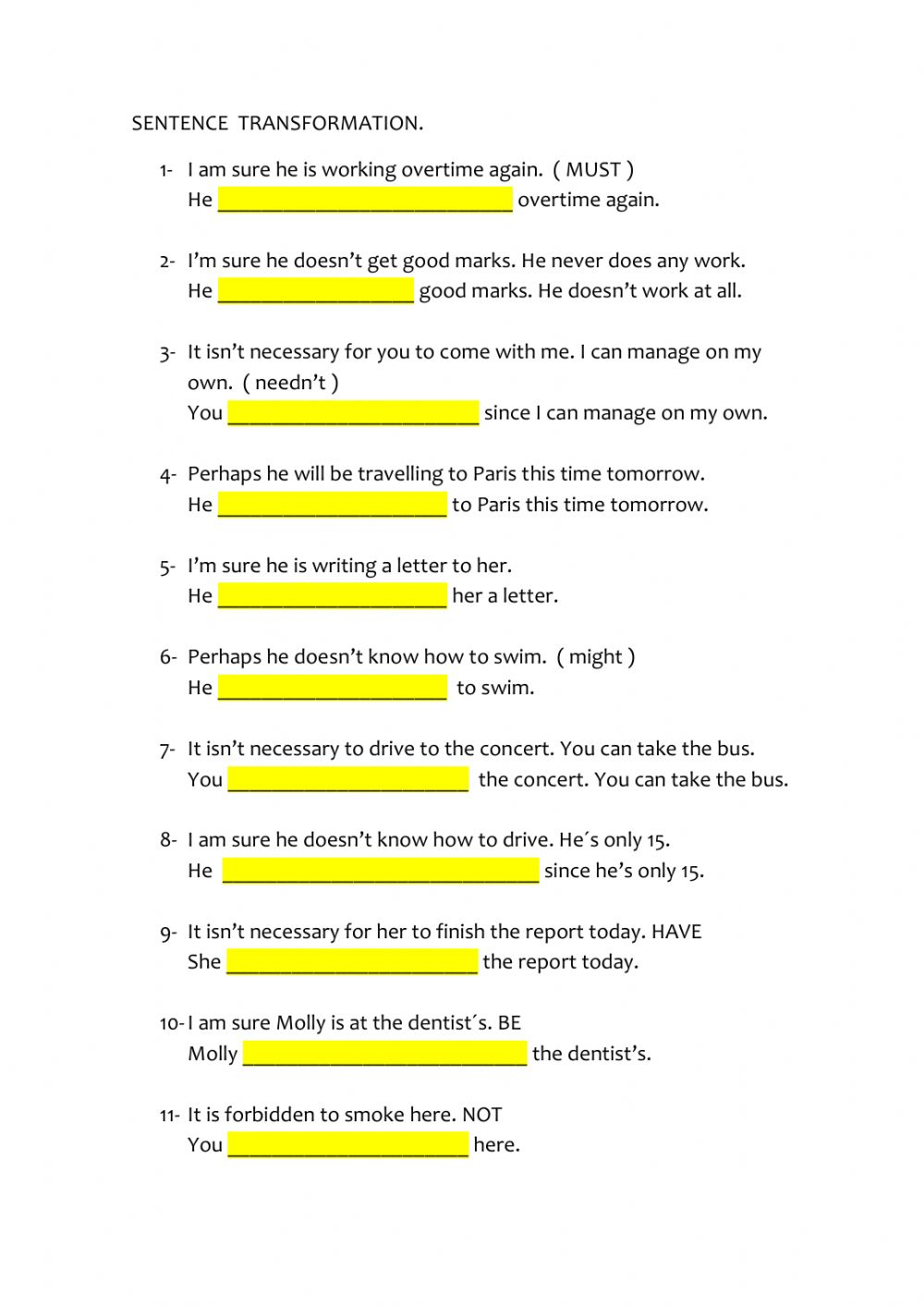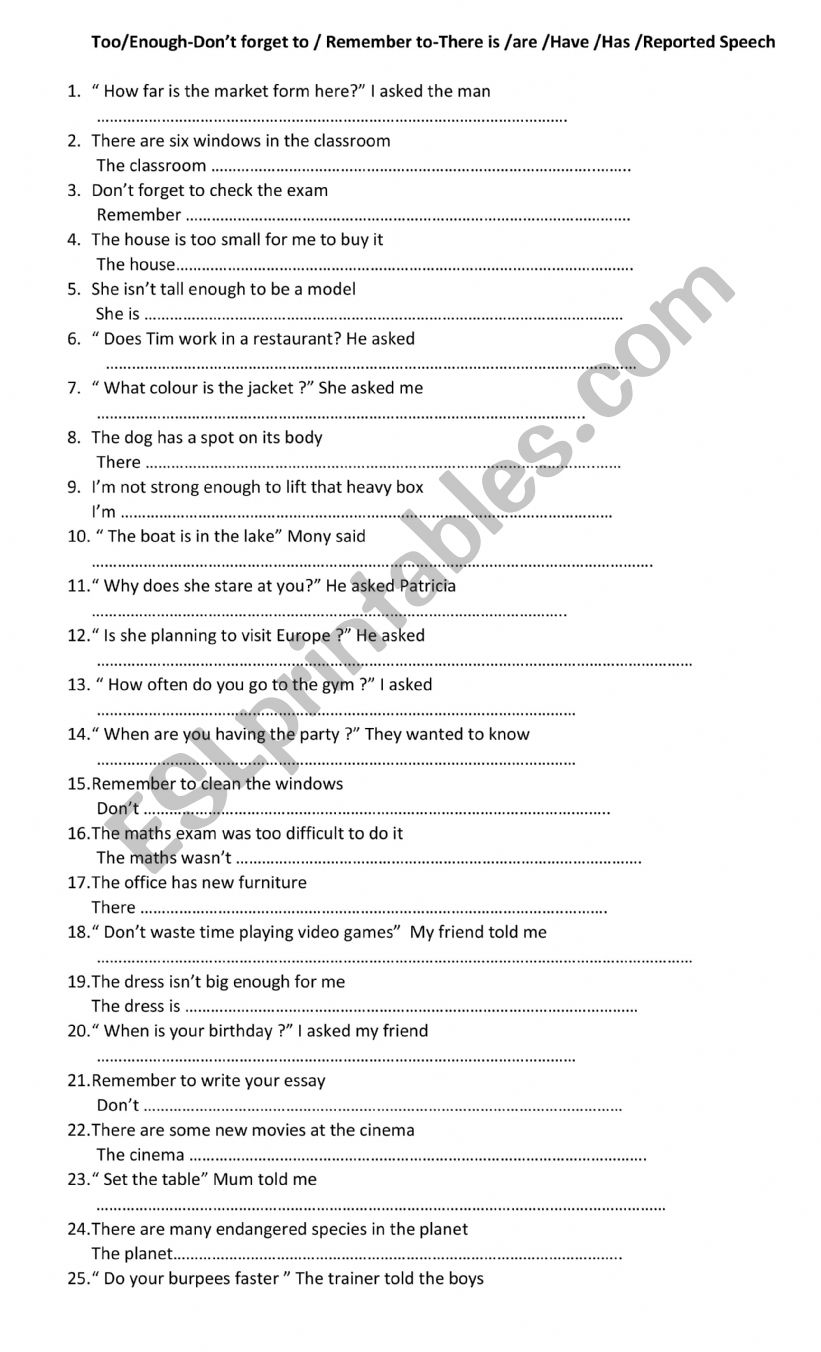
Mastering English Grammar: The Indispensable Role of Sentence Transformation Worksheets
English, with its rich tapestry of grammatical structures and nuanced expressions, often presents a formidable challenge to learners. From mastering verb tenses to understanding complex sentence constructions, the journey to fluency and accuracy demands more than mere theoretical knowledge. It requires practical application, repeated exposure, and the ability to manipulate language effectively. In this pursuit, sentence transformation worksheets emerge as an invaluable pedagogical tool, offering a dynamic and engaging approach to solidify grammatical understanding and enhance linguistic flexibility.
This article delves into the profound significance of sentence transformation worksheets, exploring their definition, the diverse types of transformations they encompass, their pedagogical benefits, and best practices for their design and implementation in educational settings.
What Are Sentence Transformation Worksheets?

At its core, sentence transformation involves altering the structure of a sentence while preserving its original meaning. It’s about expressing the same idea in different grammatical forms. Sentence transformation worksheets are structured exercises designed to guide students through this process. They typically present a sentence and instruct the student to rewrite it according to specific rules or using particular grammatical constructions.

For instance, a worksheet might ask a student to change an active voice sentence to a passive one ("The dog chased the ball" to "The ball was chased by the dog"), or to combine two simple sentences into a complex one using a subordinate conjunction. These exercises move beyond rote memorization, compelling learners to actively analyze sentence components, understand their functions, and reconstruct them syntactically.

The Pedagogical Imperative: Why They Matter

The consistent engagement with sentence transformation worksheets offers a multitude of benefits for English language learners across all proficiency levels:

-
Grammar Reinforcement and Application: They bridge the gap between abstract grammatical rules and their practical application. Students don’t just learn about the passive voice; they use it. This hands-on approach internalizes grammatical structures more effectively than passive learning.
-

Enhancing Syntactic Flexibility: A hallmark of advanced language proficiency is the ability to express ideas in varied ways. Transformation exercises train students to manipulate sentence structures, making their writing and speaking more sophisticated and less repetitive. This flexibility is crucial for effective communication, allowing speakers and writers to choose the most appropriate structure for context and emphasis.
-
Vocabulary Expansion and Nuance: Often, transforming a sentence requires the use of different vocabulary or idiomatic expressions. For example, changing a direct speech sentence to indirect speech might necessitate understanding reporting verbs beyond "said." This indirectly broadens a student’s lexical repertoire and helps them grasp the subtle differences in meaning conveyed by different constructions.

-

Developing Critical Thinking and Problem-Solving Skills: Students must analyze the original sentence, identify the grammatical elements that need to be changed, and then apply the correct rules to reconstruct it. This process fosters analytical thinking, attention to detail, and problem-solving abilities – skills transferable far beyond language learning.
-
Preparation for Standardized Tests: Many English proficiency exams (such as Cambridge English exams, TOEFL, IELTS, and various school-leaving examinations) include sections dedicated to sentence transformation or grammatical manipulation. Regular practice with these worksheets can significantly improve performance in these critical assessments.
-
Improving Fluency and Accuracy: As students become more comfortable with different sentence structures, they gain confidence in their ability to express complex ideas. This confidence, coupled with improved accuracy, contributes significantly to overall language fluency. They spend less time mentally struggling with grammar and more time focusing on conveying their message.

Common Types of Sentence Transformations
The versatility of sentence transformation worksheets lies in the wide array of grammatical structures they can address. Here are some of the most common and beneficial types of transformations:
-
Active Voice to Passive Voice (and vice-versa):
- Example: "The student wrote the essay." → "The essay was written by the student."
- Benefit: Teaches emphasis, subject-object relationship, and use of "by" phrase.
-
Direct Speech to Indirect Speech (and vice-versa):
- Example: John said, "I am going home." → John said that he was going home.
- Benefit: Focuses on tense changes, pronoun changes, and the use of reporting verbs.
-
Simple, Compound, and Complex Sentences:
- Combining simple sentences: "She is intelligent. She is beautiful." → "She is intelligent and beautiful." (Compound) or "She is beautiful as well as intelligent." (Simple)
- Transforming between types: "Despite the rain, we went for a walk." (Simple) → "Although it rained, we went for a walk." (Complex)
- Benefit: Develops understanding of conjunctions, clauses, and sentence variety.
-
Conditional Sentences (Type 0, 1, 2, 3):
- Example: "If you study, you will pass." → "Unless you study, you will not pass."
- Benefit: Reinforces the use of ‘if’ clauses, ‘unless,’ and the correct tense sequences.
-
Affirmative to Negative / Negative to Affirmative:
- Example: "He is always punctual." → "He is never late."
- Benefit: Teaches negation forms, antonyms, and maintaining meaning.
-
Interrogative to Assertive / Assertive to Interrogative:
- Example: "Is there any truth in his statement?" → "There is no truth in his statement."
- Benefit: Understands question formation and rhetorical questions.
-
Degrees of Comparison:
- Example: "Gold is more precious than any other metal." (Comparative) → "No other metal is as precious as gold." (Positive) → "Gold is the most precious metal." (Superlative)
- Benefit: Focuses on adjectives/adverbs and comparative/superlative forms.
-
Transformation using Specific Words/Phrases:
- Using ‘too…to’, ‘so…that’: "He is very weak, so he cannot walk." → "He is too weak to walk."
- Using ‘no sooner…than’, ‘hardly…when’: "As soon as he entered, the bell rang." → "No sooner had he entered than the bell rang."
- Benefit: Introduces specific idiomatic structures and their implications.
-
Transformation of Clauses (Noun, Adjective, Adverb):
- Example: "He succeeded because he worked hard." (Adverb clause) → "He succeeded due to his hard work." (Noun phrase)
- Benefit: Deepens understanding of complex sentence structures and condensing information.
Designing Effective Sentence Transformation Worksheets
For educators, designing effective sentence transformation worksheets is key to their success:
- Clear Instructions: Each exercise must have unambiguous instructions. Students should know exactly what transformation is required.
- Gradual Difficulty: Start with simpler transformations and gradually introduce more complex ones. Scaffolding is crucial for building confidence.
- Varied Exercise Types: Don’t just stick to rewriting. Incorporate fill-in-the-blanks, multiple-choice questions (where students choose the correct transformation), error identification, or even matching exercises.
- Contextual Relevance: Whenever possible, use sentences that are relevant to students’ lives or current curriculum topics. This makes the exercises more engaging and meaningful.
- Provide Examples: For each new type of transformation, provide a clear example or two to guide students.
- Include Answer Keys: For self-assessment and efficient teacher feedback, a comprehensive answer key is indispensable.
- Focus on Common Errors: Design exercises that specifically target common grammatical mistakes students make.
- Balance Quantity and Quality: A few well-designed, thoughtful exercises are more effective than a large volume of repetitive ones.
Implementing Sentence Transformation Worksheets in the Classroom
Effective implementation of sentence transformation worksheets involves more than just handing them out:
- Pre-Work Introduction: Before students begin, briefly review the grammatical concept being targeted. Explain the rules and provide examples.
- Guided Practice: Work through a few examples together as a class. This allows students to ask questions and clarifies any misunderstandings.
- Independent Practice: Allow students sufficient time to complete the worksheets independently. Circulate and offer individual support.
- Peer Review/Collaborative Work: Encourage students to work in pairs or small groups to compare answers and discuss their reasoning. This promotes peer learning and reinforces understanding.
- Post-Work Discussion and Feedback: Go over the answers as a class, discussing common errors and explaining why certain transformations are correct. Provide constructive feedback, focusing not just on right/wrong but on the underlying grammatical principles.
- Differentiation: Offer differentiated worksheets for students at varying proficiency levels. Some students might need more basic transformations, while others are ready for more complex challenges.
- Integration with Productive Skills: Encourage students to apply their newly acquired transformation skills in their writing assignments and oral presentations. This ensures the learning is transferable.
Conclusion
In the grand scheme of English language acquisition, the strategic use of sentence transformation worksheets stands out as a powerful and effective pedagogical tool. They are not merely busywork; they are vital instruments for internalizing grammatical rules, fostering linguistic flexibility, expanding vocabulary, and sharpening critical thinking skills. By providing a structured yet dynamic platform for practical application, these worksheets empower learners to move beyond passive understanding to active manipulation of the language, ultimately paving the way for greater accuracy, fluency, and confidence in their English communication. For educators, they offer a clear pathway to diagnose grammatical weaknesses and provide targeted practice, making them an indispensable component of any comprehensive English language curriculum.
